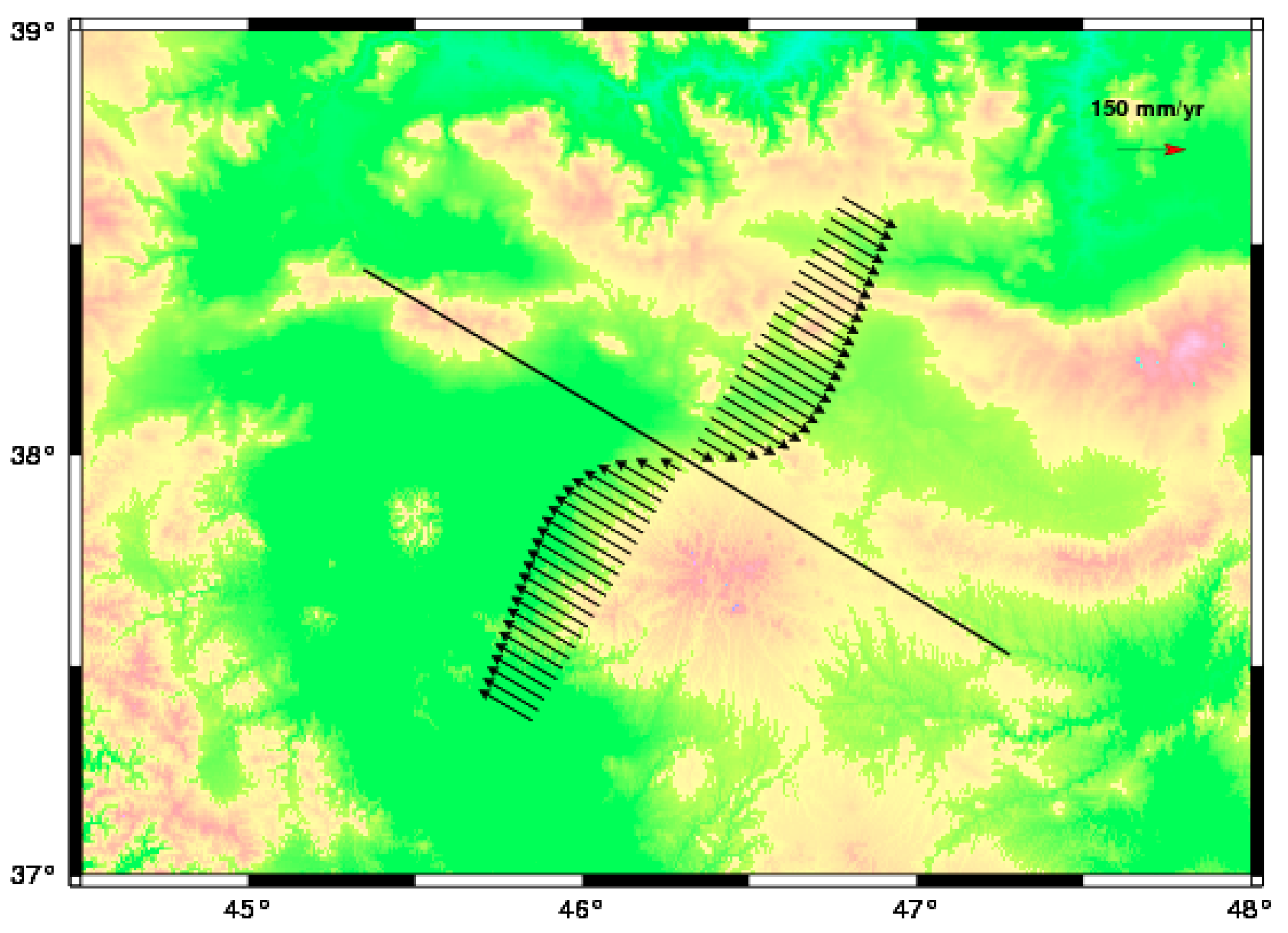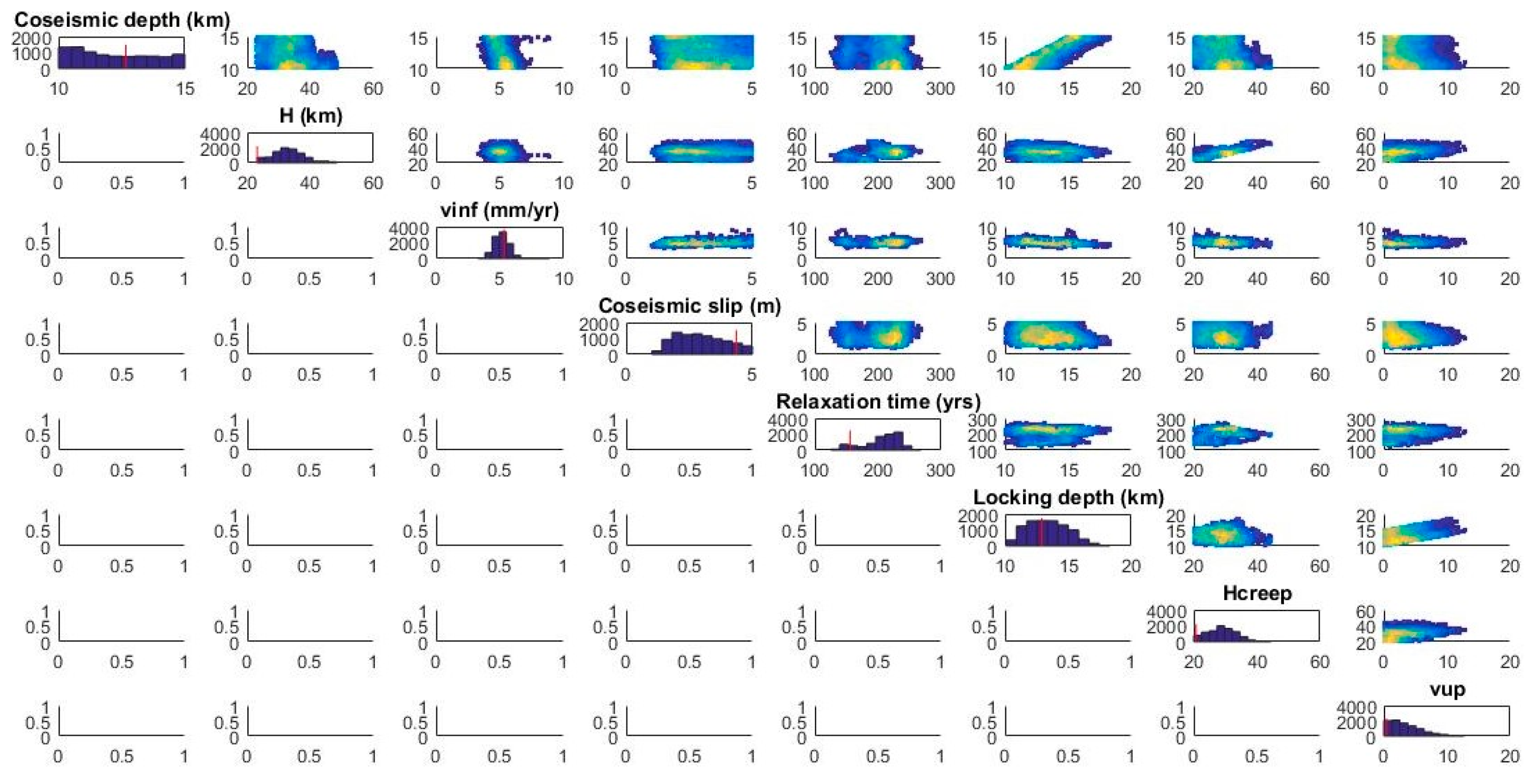Physics-Based Approach to Deep Interseismic Creep: Implications for North Tabriz Fault Behavior Using MCMC †
Abstract
:1. Introduction
2. Tectonic Setting (Study Area)
3. Data
4. Methodology
4.1. Forward Problem
4.2. A Physics-Based Approach to Deep Interseismic Creep
Slip Rate Inversion
5. Result
6. Conclusions
Author Contributions
Funding
Institutional Review Board Statement
Informed Consent Statement
Data Availability Statement
Conflicts of Interest
References
- Savage, J.C.; Burford, R.O. Accumulation of tectonic strain in California. Bull. Seismol. Soc. Am. 1970, 60, 1877–1896. [Google Scholar] [CrossRef]
- Flück, P.; Hyndman, R.D.; Wang, K. Three-dimensional dislocation model for great earthquakes of the Cascadia subduction zone. J. Geophys. Res. Solid Earth 1997, 102, 20539–20550. [Google Scholar] [CrossRef]
- Bruhat, L. A physics-based approach of deep interseismic creep for viscoelastic strike-slip earthquake cycle models. Geophys. J. Int. 2020, 220, 79–95. [Google Scholar] [CrossRef]
- Jiang, J.; Lapusta, N. Deeper penetration of large earthquakes on seismically quiescent faults. Science 2016, 352, 1293–1297. [Google Scholar] [CrossRef]
- Segall, P.; Bradley, A.M. Slow-slip evolves into megathrust earthquakes in 2D numerical simulations. Geophys. Res. Lett. 2012, 39, L18308. [Google Scholar] [CrossRef]
- Bruhat, L.; Segall, P. Deformation rates in northern Cascadia consistent with slow updip propagation of deep interseismic creep. Geophys. J. Int. 2017, 211, 427–449. [Google Scholar] [CrossRef]
- Johnson, K.M.; Segall, P. Viscoelastic earthquake cycle models with deep stress-driven creep along the San Andreas fault system. J. Geophys. Res. Solid Earth 2004, 109, B10403. [Google Scholar] [CrossRef]
- Savage, J.C.; Prescott, W.H. Asthenosphere readjustment and the earthquake cycle. J. Geophys. Res. Solid Earth 1978, 83, 3369–3376. [Google Scholar] [CrossRef]
- Segall, P. Earthquake and Volcano Deformation; Princeton University Press: Princeton, NJ, USA, 2010. [Google Scholar]
- Takeuchi, C.S.; Fialko, Y. Dynamic models of interseismic deformation and stress transfer from plate motion to continental transform faults. J. Geophys. Res. Solid Earth 2012, 117, B05403. [Google Scholar] [CrossRef]
- Hearn, E.H.; Thatcher, W.R. Reconciling viscoelastic models of postseismic and interseismic deformation: Effects of viscous shear zones and finite length ruptures. J. Geophys. Res. Solid Earth 2015, 120, 2794–2819. [Google Scholar] [CrossRef]
- Lambert, V.; Barbot, S. Contribution of viscoelastic flow in earthquake cycles within the lithosphere-asthenosphere system. Geophys. Res. Lett. 2016, 43, 10142–10154. [Google Scholar] [CrossRef]
- Allison, K.L.; Dunham, E.M. Earthquake cycle simulations with rate-and-state friction and power-law viscoelasticity. Tectonophysics 2018, 733, 232–256. [Google Scholar] [CrossRef]
- Zhang, X.; Sagiya, T. Intraplate strike-slip faulting, stress accumulation, and shear localization of a crust-upper mantle system with nonlinear viscoelastic material. J. Geophys. Res. Solid Earth 2018, 123, 9269–9285. [Google Scholar] [CrossRef]
- Rizza, M.; Vernant, P.; Ritz, J.F.; Peyret, M.; Nankali, H.; Nazari, H.; Djamour, Y.; Salamati, R.; Tavakoli, F.; Chery, J.; et al. Morphotectonic and geodetic evidence for a constant slip-rate over the last 45 kyr along the Tabriz fault (Iran). Geophys. J. Int. 2013, 193, 1083–1094. [Google Scholar] [CrossRef]
- Djamour, Y.; Vernant, P.; Nankali, H.R.; Tavakoli, F. NW Iran-eastern Turkey present-day kinematics: Results from the Iranian permanent GPS network. Earth Planet. Sci. Lett. 2011, 307, 27–34. [Google Scholar] [CrossRef]
- Khodaverdian, A.; Zafarani, H.; Rahimian, M. Long term fault slip rates, distributed deformation rates and forecast of seismicity in the Iranian Plateau. Tectonics 2015, 34, 2190–2220. [Google Scholar] [CrossRef]
- Vernant, P.; Nilforoushan, F.; Hatzfeld, D.; Abbassi, M.R.; Vigny, C.; Masson, F.; Nankali, H.; Martinod, J.; Ashtiani, A.; Bayer, R.; et al. Present-day crustal deformation and plate kinematics in the Middle East constrained by GPS measurements in Iran and northern Oman. Geophys. J. Int. 2004, 157, 381–398. [Google Scholar] [CrossRef]
- Jackson, J. Partitioning of strike-slip and convergent motion between Eurasia and Arabia in eastern Turkey and the Caucasus. J. Geophys. Res. Solid Earth 1992, 97, 12471–12479. [Google Scholar] [CrossRef]
- Berberian, M. Seismic sources of the Transcaucasian historical earthquakes. Hist. Prehist. Earthq. Cauc. 1997, 28, 233–311. [Google Scholar]
- Karakhanian, A.S.; Trifonov, V.G.; Philip, H.; Avagyan, A.; Hessami, K.; Jamali, F.; Bayraktutan, M.S.; Bagdassarian, H.; Arakelian, S.; Davtian, V.; et al. Active faulting and natural hazards in Armenia, eastern Turkey and northwestern Iran. Tectonophysics 2004, 380, 189–219. [Google Scholar] [CrossRef]
- Hessami, K.; Pantosti, D.; Tabassi, H.; Shabanian, E.; Abbassi, M.R.; Feghhi, K.; Solaymani, S. Paleoearthquakes and slip rates of the North Tabriz Fault, NW Iran: Preliminary results. Ann. Geophys. 2003, 46. [Google Scholar] [CrossRef]
- Gomberg, J.; Ellis, M. Topography and tectonics of the central New Madrid seismic zone: Results of numerical experiments using a three-dimensional boundary element program. J. Geophys. Res. Solid Earth 1994, 99, 20299–20310. [Google Scholar] [CrossRef]
- Okada, Y. Surface deformation due to shear and tensile faults in a half-space. Bull. Seismol. Soc. Am. 1985, 75, 1135–1154. [Google Scholar] [CrossRef]


| Section Number | XUTM (m) | YUTM (m) | Strike (°) | Dip (°) | Length (km) | Width (km) |
|---|---|---|---|---|---|---|
| 1 | 528,493 | 4,255,466 | 120 | 90 | 200 | 10,000 |
| Parameter | D (km) | H (km) | V∞ (mm/year) | C (m) | tR (year) | d (km) | Hcreep (km) | α (mm/year) |
|---|---|---|---|---|---|---|---|---|
| value | 14.98 | 28.89 | 7 | 3.15 | 136.36 | 15 | 27.21 | 29.03 |
| Parameter | Symbol | Minimum | Maximum |
|---|---|---|---|
| Maximum depth of full earthquake rupture, km | D | 10 | 15 |
| Long-term fault slip rate, mm/year | v∞ | 3 | 12 |
| Elastic thickness, km | H | 23 | 100 |
| Half-space relaxation time, years | tR | 0 | 500 |
| Coseismic displacement, m | Δu | 1 | 5 |
| Present-day locking depth, km | d | D | H |
| Depth of constant creep, km | Hcreep | d | H |
| Recurrence time, m/year | T | ||
| Propagation speed, m/year | vup | ||
| Time since 1786 earthquake, years | t | 237 | 237 (fixed) |
| Block motion, mm/year | none | none |
Disclaimer/Publisher’s Note: The statements, opinions and data contained in all publications are solely those of the individual author(s) and contributor(s) and not of MDPI and/or the editor(s). MDPI and/or the editor(s) disclaim responsibility for any injury to people or property resulting from any ideas, methods, instructions or products referred to in the content. |
© 2023 by the authors. Licensee MDPI, Basel, Switzerland. This article is an open access article distributed under the terms and conditions of the Creative Commons Attribution (CC BY) license (https://creativecommons.org/licenses/by/4.0/).
Share and Cite
Salmaniyan, M.; Rastbood, A.; Hossainali, M.M. Physics-Based Approach to Deep Interseismic Creep: Implications for North Tabriz Fault Behavior Using MCMC. Eng. Proc. 2023, 56, 26. https://doi.org/10.3390/ASEC2023-15239
Salmaniyan M, Rastbood A, Hossainali MM. Physics-Based Approach to Deep Interseismic Creep: Implications for North Tabriz Fault Behavior Using MCMC. Engineering Proceedings. 2023; 56(1):26. https://doi.org/10.3390/ASEC2023-15239
Chicago/Turabian StyleSalmaniyan, Milad, Asghar Rastbood, and Masoud Mashhadi Hossainali. 2023. "Physics-Based Approach to Deep Interseismic Creep: Implications for North Tabriz Fault Behavior Using MCMC" Engineering Proceedings 56, no. 1: 26. https://doi.org/10.3390/ASEC2023-15239
APA StyleSalmaniyan, M., Rastbood, A., & Hossainali, M. M. (2023). Physics-Based Approach to Deep Interseismic Creep: Implications for North Tabriz Fault Behavior Using MCMC. Engineering Proceedings, 56(1), 26. https://doi.org/10.3390/ASEC2023-15239






